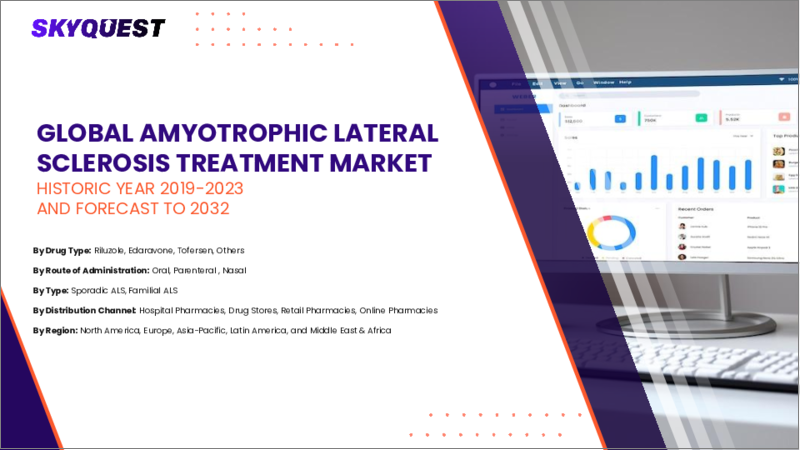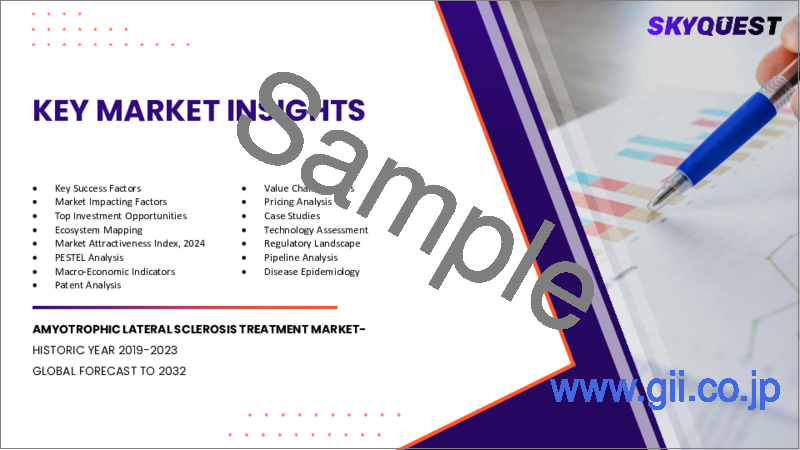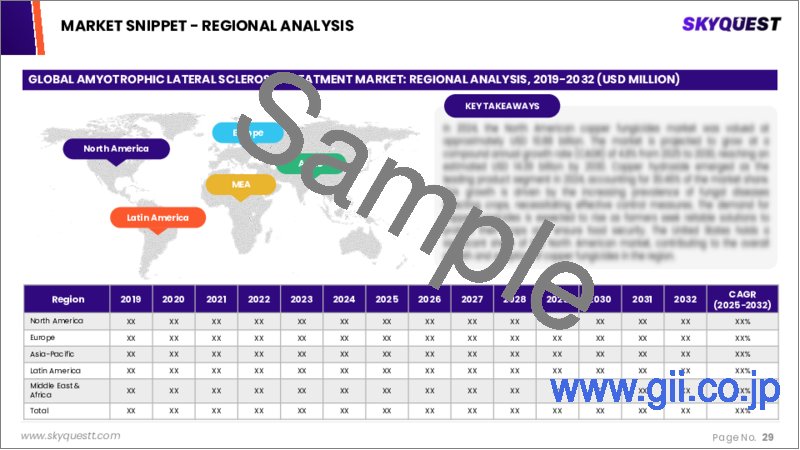|
|
市場調査レポート
商品コード
1646224
筋萎縮性側索硬化症治療の市場規模、シェア、成長分析:治療法別、タイプ別、流通チャネル別、地域別 - 産業予測 2025~2032年Amyotrophic Lateral Sclerosis Treatment Market Size, Share, Growth Analysis, By Treatment (Medication, Stem Cell Therapy), By Type (Sporadic ALS, Familial ALS), By Distribution Channel, By Region - Industry Forecast 2025-2032 |
||||||
|
|||||||
| 筋萎縮性側索硬化症治療の市場規模、シェア、成長分析:治療法別、タイプ別、流通チャネル別、地域別 - 産業予測 2025~2032年 |
|
出版日: 2025年01月25日
発行: SkyQuest
ページ情報: 英文 242 Pages
納期: 3~5営業日
|
全表示
- 概要
- 目次
筋萎縮性側索硬化症治療市場規模は2023年に7億1,145万米ドルと評価され、予測期間中(2025~2032年)にCAGR 5.7%で成長し、2024年の7億5,200万米ドルから2032年には11億7,171万米ドルに拡大する見通しです。
筋萎縮性側索硬化症(ALS)はルー・ゲーリッグ病としても知られ、中枢神経系における神経細胞の損傷により随意筋の制御に影響を及ぼす進行性の神経変性疾患です。症状としては、筋肉の痙攣、こわばり、脱力などがあり、嚥下、会話、運動などの基本的な機能が失われます。ALSの約90~95%は散発性であり、残りは家族性ALS(FALS)で、主にC9ORF72遺伝子の変異など遺伝的要素が大きいです。現在、ALSを完治させる治療法は確立されていませんが、薬物療法や幹細胞治療のような先進治療による症状管理が重要であり、世界のALS治療市場の成長を促進すると期待されています。この課題に対処するためには、継続的な調査と技術革新が不可欠です。
目次
イントロダクション
- 調査の目的
- 調査範囲
- 定義
調査手法
- 情報調達
- 二次データと一次データの方法
- 市場規模予測
- 市場の前提条件と制限
エグゼクティブサマリー
- 世界市場の見通し
- 供給と需要の動向分析
- セグメント別機会分析
市場力学と見通し
- 市場概要
- 市場規模
- 市場力学
- 促進要因と機会
- 抑制要因と課題
- ポーターの分析
主な市場の考察
- 重要成功要因
- 競合の程度
- 主な投資機会
- 市場エコシステム
- 市場の魅力指数(2024年)
- PESTEL分析
- マクロ経済指標
- バリューチェーン分析
- 価格分析
- ケーススタディ
- 技術の進歩
- 規制情勢
- 特許分析
筋萎縮性側索硬化症治療市場規模:治療法別
- 市場概要
- 薬
- 幹細胞療法
- 理学療法
- 言語療法
筋萎縮性側索硬化症治療市場規模:タイプ別
- 市場概要
- 散発性ALS
- 家族性ALS
筋萎縮性側索硬化症治療市場規模:流通チャネル別
- 市場概要
- 病院薬局
- 小売薬局
- オンライン薬局
筋萎縮性側索硬化症治療市場規模
- 北米
- 米国
- カナダ
- 欧州
- ドイツ
- スペイン
- フランス
- 英国
- イタリア
- その他欧州地域
- アジア太平洋地域
- 中国
- インド
- 日本
- 韓国
- その他アジア太平洋地域
- ラテンアメリカ
- ブラジル
- その他ラテンアメリカ地域
- 中東・アフリカ
- GCC諸国
- 南アフリカ
- その他中東・アフリカ
競合情報
- 上位5社の比較
- 主要企業の市場ポジショニング(2024年)
- 主な市場企業が採用した戦略
- 市場の最近の動向
- 企業の市場シェア分析(2024年)
- 主要企業の企業プロファイル
- 会社概要
- 製品ポートフォリオ分析
- セグメント別シェア分析
- 収益の前年比比較(2022~2024年)
主要企業プロファイル
- Mitsubishi Tanabe Pharma Corporation(Japan)
- Biogen Inc.(USA)
- BrainStorm Cell Therapeutics Inc.(USA)
- Amylyx Pharmaceuticals, Inc.(USA)
- Ionis Pharmaceuticals, Inc.(USA)
- Sanofi(France)
- Otsuka Pharmaceutical Co., Ltd.(Japan)
- F. Hoffmann-La Roche Ltd(Switzerland)
- AB Science(France)
- Sun Pharmaceutical Industries Ltd.(India)
- Orion Corporation(Finland)
- CORESTEMCHEMON Inc.(South Korea)
- Cytokinetics, Inc.(USA)
- MediciNova, Inc.(USA)
- Mitsubishi Chemical Group Corporation(Japan)
- Apellis Pharmaceuticals, Inc.(USA)
- Denali Therapeutics Inc.(USA)
- Genentech, Inc.(USA)
- Treeway B.V.(Netherlands)
結論と推奨事項
Amyotrophic Lateral Sclerosis Treatment Market size was valued at USD 711.45 million in 2023 and is poised to grow from USD 752.0 million in 2024 to USD 1171.71 million by 2032, growing at a CAGR of 5.7% during the forecast period (2025-2032).
Amyotrophic lateral sclerosis (ALS), also known as Lou Gehrig's disease, is a progressive neurodegenerative disorder affecting voluntary muscle control due to nerve cell damage in the central nervous system. Symptoms include muscle twitching, stiffness, and weakness, leading to the loss of essential functions like swallowing, speaking, and mobility. Approximately 90-95% of ALS cases are sporadic, while familial ALS (FALS) accounts for the remainder, with significant genetic components, primarily the C9ORF72 gene mutation. While there is currently no cure for ALS, symptom management through medications and advanced therapies like stem cell treatments is critical and expected to fuel the growth of the global ALS treatment market. Continued research and innovation are essential in addressing this challenging condition.
Top-down and bottom-up approaches were used to estimate and validate the size of the Amyotrophic Lateral Sclerosis Treatment market and to estimate the size of various other dependent submarkets. The research methodology used to estimate the market size includes the following details: The key players in the market were identified through secondary research, and their market shares in the respective regions were determined through primary and secondary research. This entire procedure includes the study of the annual and financial reports of the top market players and extensive interviews for key insights from industry leaders such as CEOs, VPs, directors, and marketing executives. All percentage shares split, and breakdowns were determined using secondary sources and verified through Primary sources. All possible parameters that affect the markets covered in this research study have been accounted for, viewed in extensive detail, verified through primary research, and analyzed to get the final quantitative and qualitative data.
Amyotrophic Lateral Sclerosis Treatment Market Segments Analysis
Global Amyotrophic Lateral Sclerosis Treatment Market is segmented by Treatment, Type, Distribution Channel and region. Based on Treatment, the market is segmented into Medication, Stem Cell Therapy, Physical Therapy and Speech Therapy. Based on Type, the market is segmented into Sporadic ALS and Familial ALS. Based on Distribution Channel, the market is segmented into Hospital Pharmacies, Retail Pharmacies and Online Pharmacies. Based on region, the market is segmented into North America, Europe, Asia Pacific, Latin America and Middle East & Africa.
Driver of the Amyotrophic Lateral Sclerosis Treatment Market
The growth of the Amyotrophic Lateral Sclerosis (ALS) treatment market is anticipated to be significantly influenced by the increasing prevalence of the disease. Data from the Centers for Disease Control and Prevention (CDC) indicated that in 2016, approximately 14,500 to 15,000 individuals in the United States were living with ALS, with around 5,000 new diagnoses occurring each year. Furthermore, globally, ALS affects about 2 to 5 individuals per 100,000. The rise in sedentary lifestyles and a growing elderly population also contribute to the heightened demand for both targeted and symptomatic treatments, which will likely stimulate the ALS treatment market in the coming years.
Restraints in the Amyotrophic Lateral Sclerosis Treatment Market
The amyotrophic lateral sclerosis (ALS) treatment market faces several significant restraints that are likely to hinder its growth during the forecast period. The high cost of treatment is a primary concern, as ALS is a rare condition, leading to exorbitant expenses that can reach approximately $200,000 annually, including medication like Edaravone, which alone costs around $145,000. Additionally, there is a general lack of awareness regarding ALS, which further limits patient access to treatment options. Moreover, the uncertainty surrounding the effectiveness of these costly treatments, associated with low survival rates, presents a substantial challenge for market expansion and patient confidence.
Market Trends of the Amyotrophic Lateral Sclerosis Treatment Market
The amyotrophic lateral sclerosis (ALS) treatment market is witnessing significant growth driven by the increasing prevalence of neurodegenerative disorders amidst busy lifestyles and rising incidences of ALS. The expanding geriatric population, particularly vulnerable to such conditions, is further propelling market expansion. Additionally, various NGOs and private organizations are actively promoting awareness campaigns focused on ALS diagnosis and treatment, fostering a more informed patient base and enhancing market outlook. The emergence of targeted symptomatic treatments aimed at alleviating ALS symptoms is also contributing to market growth, reflecting a robust trend towards more personalized and effective therapeutic solutions in the ALS landscape.
Table of Contents
Introduction
- Objectives of the Study
- Scope of the Report
- Definitions
Research Methodology
- Information Procurement
- Secondary & Primary Data Methods
- Market Size Estimation
- Market Assumptions & Limitations
Executive Summary
- Global Market Outlook
- Supply & Demand Trend Analysis
- Segmental Opportunity Analysis
Market Dynamics & Outlook
- Market Overview
- Market Size
- Market Dynamics
- Drivers & Opportunities
- Restraints & Challenges
- Porters Analysis
- Competitive rivalry
- Threat of substitute
- Bargaining power of buyers
- Threat of new entrants
- Bargaining power of suppliers
Key Market Insights
- Key Success Factors
- Degree of Competition
- Top Investment Pockets
- Market Ecosystem
- Market Attractiveness Index, 2024
- PESTEL Analysis
- Macro-Economic Indicators
- Value Chain Analysis
- Pricing Analysis
- Case Studies
- Technology Advancement
- Regulatory Landscape
- Patent Analysis
Global Amyotrophic Lateral Sclerosis Treatment Market Size by Treatment & CAGR (2025-2032)
- Market Overview
- Medication
- Stem Cell Therapy
- Physical Therapy
- Speech Therapy
Global Amyotrophic Lateral Sclerosis Treatment Market Size by Type & CAGR (2025-2032)
- Market Overview
- Sporadic ALS
- Familial ALS
Global Amyotrophic Lateral Sclerosis Treatment Market Size by Distribution Channel & CAGR (2025-2032)
- Market Overview
- Hospital Pharmacies
- Retail Pharmacies
- Online Pharmacies
Global Amyotrophic Lateral Sclerosis Treatment Market Size & CAGR (2025-2032)
- North America (Treatment, Type, Distribution Channel)
- US
- Canada
- Europe (Treatment, Type, Distribution Channel)
- Germany
- Spain
- France
- UK
- Italy
- Rest of Europe
- Asia Pacific (Treatment, Type, Distribution Channel)
- China
- India
- Japan
- South Korea
- Rest of Asia-Pacific
- Latin America (Treatment, Type, Distribution Channel)
- Brazil
- Rest of Latin America
- Middle East & Africa (Treatment, Type, Distribution Channel)
- GCC Countries
- South Africa
- Rest of Middle East & Africa
Competitive Intelligence
- Top 5 Player Comparison
- Market Positioning of Key Players, 2024
- Strategies Adopted by Key Market Players
- Recent Developments in the Market
- Company Market Share Analysis, 2024
- Company Profiles of All Key Players
- Company Details
- Product Portfolio Analysis
- Company's Segmental Share Analysis
- Revenue Y-O-Y Comparison (2022-2024)
Key Company Profiles
- Mitsubishi Tanabe Pharma Corporation (Japan)
- Company Overview
- Business Segment Overview
- Financial Updates
- Key Developments
- Biogen Inc. (USA)
- Company Overview
- Business Segment Overview
- Financial Updates
- Key Developments
- BrainStorm Cell Therapeutics Inc. (USA)
- Company Overview
- Business Segment Overview
- Financial Updates
- Key Developments
- Amylyx Pharmaceuticals, Inc. (USA)
- Company Overview
- Business Segment Overview
- Financial Updates
- Key Developments
- Ionis Pharmaceuticals, Inc. (USA)
- Company Overview
- Business Segment Overview
- Financial Updates
- Key Developments
- Sanofi (France)
- Company Overview
- Business Segment Overview
- Financial Updates
- Key Developments
- Otsuka Pharmaceutical Co., Ltd. (Japan)
- Company Overview
- Business Segment Overview
- Financial Updates
- Key Developments
- F. Hoffmann-La Roche Ltd (Switzerland)
- Company Overview
- Business Segment Overview
- Financial Updates
- Key Developments
- AB Science (France)
- Company Overview
- Business Segment Overview
- Financial Updates
- Key Developments
- Sun Pharmaceutical Industries Ltd. (India)
- Company Overview
- Business Segment Overview
- Financial Updates
- Key Developments
- Orion Corporation (Finland)
- Company Overview
- Business Segment Overview
- Financial Updates
- Key Developments
- CORESTEMCHEMON Inc. (South Korea)
- Company Overview
- Business Segment Overview
- Financial Updates
- Key Developments
- Cytokinetics, Inc. (USA)
- Company Overview
- Business Segment Overview
- Financial Updates
- Key Developments
- MediciNova, Inc. (USA)
- Company Overview
- Business Segment Overview
- Financial Updates
- Key Developments
- Mitsubishi Chemical Group Corporation (Japan)
- Company Overview
- Business Segment Overview
- Financial Updates
- Key Developments
- Apellis Pharmaceuticals, Inc. (USA)
- Company Overview
- Business Segment Overview
- Financial Updates
- Key Developments
- Denali Therapeutics Inc. (USA)
- Company Overview
- Business Segment Overview
- Financial Updates
- Key Developments
- Genentech, Inc. (USA)
- Company Overview
- Business Segment Overview
- Financial Updates
- Key Developments
- Treeway B.V. (Netherlands)
- Company Overview
- Business Segment Overview
- Financial Updates
- Key Developments





